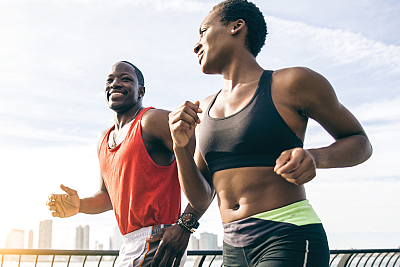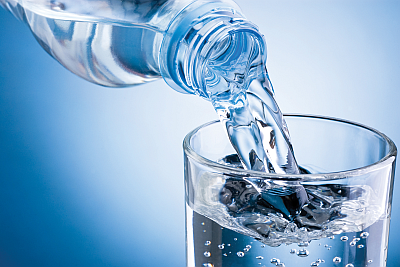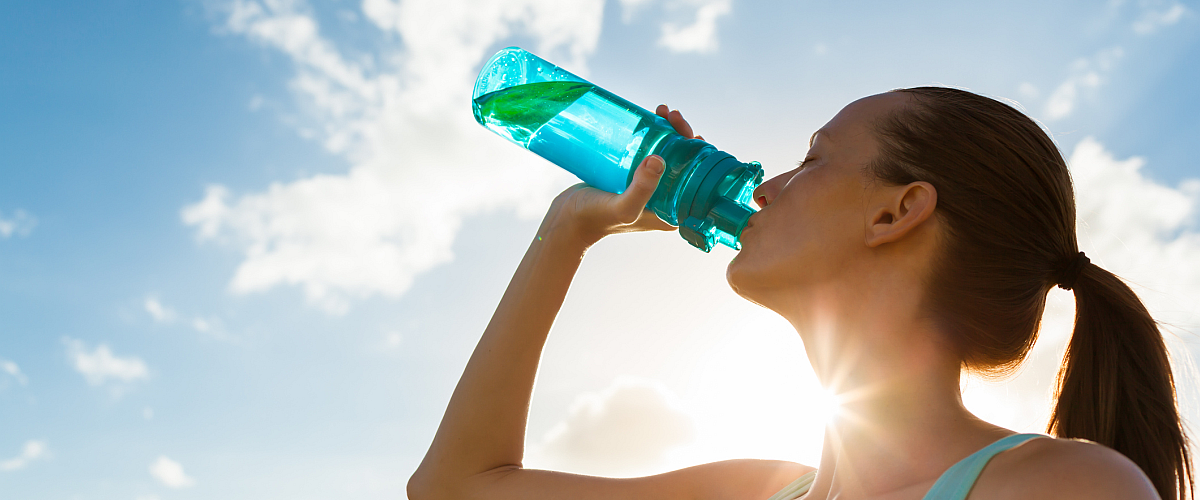Summertime is full of sunshine and outdoor activities. With all this on-the-go, fun in the sun comes with an additional responsibility to stay hydrated.
Our bodies are about 2/3 water, which regulates temperature, lubricates joints and tissues, maintains healthy digestion, ensures cells are functioning properly, and a host of other duties. Most people meet their daily hydration needs (about 9 to 12 glasses per day) by drinking when they’re thirsty. However, these needs are greater in hot climates or during physical activity.
Sweaty Statistics
 Being active increases our heart rate and raises our body temperature, and this effect is amplified in a hot climate. Sweating is our body’s reaction to those extra degrees and our natural way of cooling down (think running through the sprinklers, but from the inside out). As cooler air passes over the water on our bodies, it results in a cooling effect called convection.
Being active increases our heart rate and raises our body temperature, and this effect is amplified in a hot climate. Sweating is our body’s reaction to those extra degrees and our natural way of cooling down (think running through the sprinklers, but from the inside out). As cooler air passes over the water on our bodies, it results in a cooling effect called convection.
According to the American College of Sports Medicine (ACSM), sweat rates can range from 1 to 4 pounds (4 pounds is a half gallon of water!) per hour. Sweat loss varies by person depending on body weight and other factors, but it tends to increase in the heat and during prolonged activity. For example, a 110-pound slow runner might lose one pound of sweat per hour, while a 200-pound fast runner might lose four. Football players could lose more than 2 gallons of sweat in a day! Perhaps surprisingly, swimmers sweat, too—almost a pound per hour of training—so it’s important to hydrate even if you plan on swimming, surfing, or participating in any other water-related activities.
Hydrating for Performance: Don’t Wait ‘til It’s Too Late!
Losing sweat doesn’t only mean losing water.
“When we perspire, we lose important electrolytes like sodium, potassium, calcium, and magnesium that need to be replenished for our bodies to function properly,” says Aramark registered dietitian Amy Siverling. “Calcium and magnesium are important for muscle function. Sodium and potassium help with fluid balance and are critical to heart function.”
Dehydration may seem harmless, but can quickly cause decreases in both physical and mental performance, and can cause cramping, fatigue, vomiting, dizziness, confusion, and an increased risk for heat stroke, especially in hot conditions.
Chances are, if you’re already thirsty, you’re probably already dehydrated! “It may seem like a quick sip after exercising will be enough, but staying properly hydrated means drinking before, during and after physical activity,” Amy says. Each hour of activity means an extra 18 to 36 ounces (2-4 glasses) of fluid is needed in addition to the recommended 9 to 12 glasses per day.
 Healthy Hydration Tips
Healthy Hydration Tips
The most natural way to hydrate, of course, is by drinking water. For everyday hydration and moderate workouts lasting less than an hour, plain old H2O is usually the best choice. It’s not the only healthy choice, though!
Many fruits and vegetables like tomatoes, cucumbers, watermelon , cantaloupe, zucchini and other squashes all contain over 90% water. These water-filled foods are great ways to get creative with your hydration. Check out our blog post on healthy hydration for more inspiration and other tips and tricks to get started!
It can be easy to get caught up when we’re in the zone training or having fun in the sun, but remember that, whether you’re gearing up for an athletic event or just out for a walk, hydrating is key to staying energized, active and healthy.
So get out, get moving, and enjoy the sunshine, but don’t forget to fuel your “go” with H2O!
Note: Since everyone’s health history and nutritional needs are so different, please make sure that you talk with your doctor and a registered dietitian to get advice about the diet and exercise plan that‘s right for you.

